Volatility timing
Contents
import pandas as pd
import numpy as np
import matplotlib.pyplot as plt
%matplotlib inline
12.1. Volatility timing#
Using daily data for month t, construct the market return “realized variance” during month t
where \(\overline{R}\) is the average return within the month
Buy the market at the closing price of month t accoding to the rule:
where \(c\) is some constant.
Hold the postions for a month
The returns of the strategy are given by
One could use a variety of other volatiltiy estimators to implement the strategy
Use Squared returns instead of variance
VIX (my favourite)
GARCH based forecasts
Regression forecasts based lagged rv
Regression forecasts based lagged rv and VIX
For this implementation which was developed in a paper of mine with Tyler Muir we simply need daily data to construct the realized variance variable (VIX is great but only available for a short sample)
Download data from WRDS
(if you have credentials)
import datetime as dt
import wrds
import psycopg2
from dateutil.relativedelta import *
# connect with their server
#conn=wrds.Connection()
# get the value-weighted market returns and date from the data base crsp.dsi
mkt_d = conn.raw_sql("""
select a.date, a.vwretd
from crsp.dsi as a
""")
# get the risk-free rate
rf_d = conn.raw_sql("""
select a.date, a.rf
from ff.factors_daily as a
""")
mkt_d=mkt_d.set_index(['date'])
mkt_d=mkt_d.set_index(pd.to_datetime(mkt_d.index),'date')
rf_d=rf_d.set_index(['date'])
rf_d=rf_d.set_index(pd.to_datetime(rf_d.index),'date')
# we merge
daily=mkt_d.merge(rf_d,how='left',left_index=True,right_index=True)
# save data locally
#daily.to_pickle('../../assets/data/daily.pkl')
Alternatively simply import from Gihub by substituting the address below
daily=pd.read_pickle('https://github.com/amoreira2/Lectures/blob/main/assets/data/daily.pkl?raw=true')
12.1.1. Constructing monthly realized variance from daily data#
You basically use pandas time series function that shifts all dates to the end of the month, so this way you are technically grouping by the end of the month day.
daily.index
DatetimeIndex(['1925-12-31', '1926-01-02', '1926-01-04', '1926-01-05',
'1926-01-06', '1926-01-07', '1926-01-08', '1926-01-09',
'1926-01-11', '1926-01-12',
...
'2020-12-17', '2020-12-18', '2020-12-21', '2020-12-22',
'2020-12-23', '2020-12-24', '2020-12-28', '2020-12-29',
'2020-12-30', '2020-12-31'],
dtype='datetime64[ns]', name='date', length=25046, freq=None)
Now I use groupby endofmonth to put all returns of given “year-month” pair together (i.e. with the same date)
from pandas.tseries.offsets import MonthEnd
endofmonth=daily.index+MonthEnd(0)
endofmonth
DatetimeIndex(['1925-12-31', '1926-01-31', '1926-01-31', '1926-01-31',
'1926-01-31', '1926-01-31', '1926-01-31', '1926-01-31',
'1926-01-31', '1926-01-31',
...
'2020-12-31', '2020-12-31', '2020-12-31', '2020-12-31',
'2020-12-31', '2020-12-31', '2020-12-31', '2020-12-31',
'2020-12-31', '2020-12-31'],
dtype='datetime64[ns]', name='date', length=25046, freq=None)
So I can jsut compute the variance of this group (say 1/1/2020,1/2/2020,…1/31/2020 will all be 1/31/2020
This will return the daily variance in that month
So the ouput will be one realized variance for each month
# We denote `realized variance` for the market return as `RV`
RV=daily[['vwretd']].groupby(endofmonth).var()
# rename column to clarify
RV=RV.rename(columns={'vwretd':'RV'})
RV.plot()
<AxesSubplot:xlabel='date'>
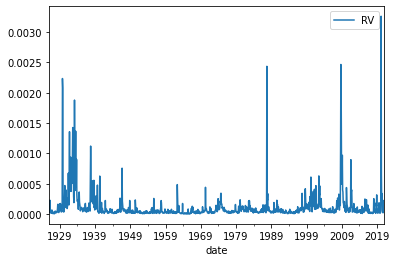
12.1.2. From signal to weights#
weight on the market:
weight on the risk-free rate: \(1-w_t\)
\(c\) controls how levered is the strategy on average.
As we saw before all timing strategies involved some in and out of the market, but you also need to determine the average position. That is the role of \(c\).
There are many ways to choose c
while c does not impact the strategy Sharpe Ratio, it impacts the amount of leverage that the strategy will take
Here lets keep it simple and simply choose it so that the postion on the market is 1 on average
implies \(c=\frac{1}{E[\frac{1}{rv_t}]}\)
# calculate weights for the risky assets (market)
c=1/(1/RV.RV).mean()
RV['Weight']=c/RV.RV
RV.Weight.plot()
RV.Weight.mean()
0.918452009960208
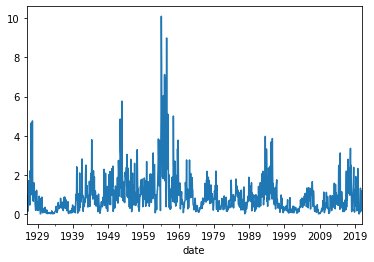
# plot the weights on the risk-free rate
(1-RV.Weight).plot()
plt.show()
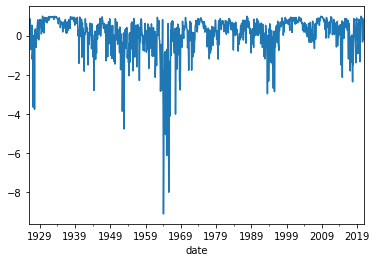
12.1.3. Aggregate daily returns to monthly returns#
Since the strategy will trade monthly, we now need to construct monthly returns
we do that by cumulating daily returns within a month
# aggregate daily returns to monthly returns
Ret=(1+daily).groupby(endofmonth).prod()-1
# rename columns to clarify
Ret.tail()
| vwretd | rf | |
|---|---|---|
| date | ||
| 2020-08-31 | 0.068549 | 0.0 |
| 2020-09-30 | -0.034910 | 0.0 |
| 2020-10-31 | -0.020180 | 0.0 |
| 2020-11-30 | 0.123639 | 0.0 |
| 2020-12-31 | 0.044672 | 0.0 |
# have we discussed merge before?
# Merge Ret (monthly return) with RV (realized variance and weights)
df=RV.merge(Ret,how='left',left_index=True,right_index=True)
df.tail()
| RV | Weight | vwretd | rf | |
|---|---|---|---|---|
| date | ||||
| 2020-08-31 | 0.000024 | 1.323402 | 0.068549 | 0.0 |
| 2020-09-30 | 0.000228 | 0.139017 | -0.034910 | 0.0 |
| 2020-10-31 | 0.000154 | 0.206066 | -0.020180 | 0.0 |
| 2020-11-30 | 0.000090 | 0.353568 | 0.123639 | 0.0 |
| 2020-12-31 | 0.000027 | 1.185148 | 0.044672 | 0.0 |
12.1.4. Construct strategy returns#
Now to construct the strategy return recall that we use the relaized variance in month t to buy the market at the closing of month t and earn the return accrued in month t+1
So we need to lag our weights, or lead the returns
I will call the strategy as \(\textbf{VMS}\) (Volatility Managed Strategy)
# compare with the weight before . It simply shifts the weght from month t to month t+1
df.Weight.shift(1).tail()
date
2020-08-31 0.435234
2020-09-30 1.323402
2020-10-31 0.139017
2020-11-30 0.206066
2020-12-31 0.353568
Name: Weight, dtype: float64
# now construct the return of the strategy
df['VMS']=df.Weight.shift(1)*df.vwretd+(1-df.Weight.shift(1))*df.rf
We can see the cumulative returns of the market and the volatility managed strategy
(df[['vwretd','VMS']]+1).cumprod().plot(logy=True)
<AxesSubplot:xlabel='date'>
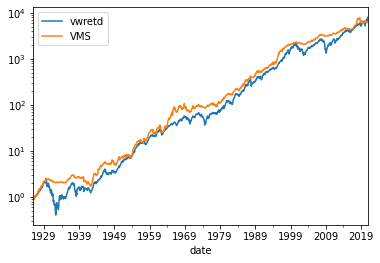
Volatility is more stable
df[['vwretd','VMS']].rolling(window=24).var().plot()
<AxesSubplot:xlabel='date'>
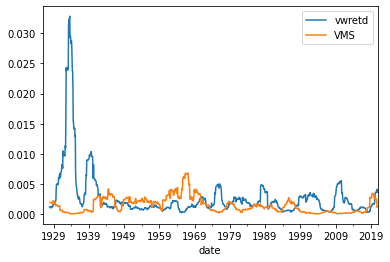
Average returns
df[['vwretd','VMS']].rolling(window=24).mean().plot()
<AxesSubplot:xlabel='date'>

Sharpe ratio
The VMS strategy ends up with a 20% higher Sharpe Ratio
(df[['vwretd','VMS']].subtract(df.rf,axis=0).mean()/df[['vwretd','VMS']].std())*12**0.5
vwretd 0.431226
VMS 0.513687
dtype: float64
Tail risk
The VMS bears substantially less tail risk as well
We can look at the bottom 0.5% returns
df[['vwretd','VMS']].quantile(q=0.005)
vwretd -0.187543
VMS -0.133776
Name: 0.005, dtype: float64


